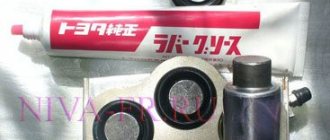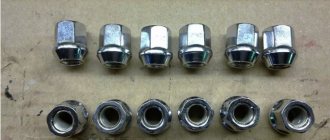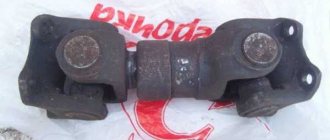The petrol, carburetor engine VAZ 21213 1.7L was developed in Russia by the AvtoVAZ plant, where from 1994 to the present it has been manufactured to equip the VAZ 2107 and off-road vehicles of its own production VAZ Niva: 2121 and Niva Pickup. The ICE 21214 was designed on its basis. The power unit of the VAZ 21213 is a motor assembly with a five-speed manual transmission.
These SUVs are considered popular among residents in rural areas due to their increased cross-country ability, as well as among fishermen, hunters and lovers of various types of quiet hunting (mushroom pickers, berry pickers, etc.), as they cope well with off-road conditions in all seasons. In most cases, this category of people use their Nivas over short distances and their annual mileage is comparatively small compared to cars used in cities. I will not go into the reliability of the listed cars, but you can draw your own conclusion about the reliability of the VAZ 21213 engine based on its sores, disadvantages, weak points and shortcomings.
The service life of the internal combustion engine is not long (see table), but it can be overhauled; it is a pity, of course, that there are no liners in the design of the cylinder block and the cylinders have to be bored to repair sizes. Initially, the pistons and cylinders of the engine have five performance classes based on the size of the deviations. The difference in size for each class from the previous one is 0.01 mm. The classes in the marking are indicated by letters and they have corresponding tolerance fields: A (82.00-82.01 mm), B (82.01-82.02 mm), C (82.02-82.03 mm), D (82.03-82.04 mm), E (82.04-82.05 mm ). When selecting pistons and cylinders in a block, their classes, i.e., their letter designations must match. The piston pin hole diameter class has numerical designations from 1 to 3 and an arrow indicating the direction to the front of the engine. The repair dimensions of pistons and cylinders for the first and second overhaul are shown in the table.
Main characteristics of internal combustion engine 21213
| Volume, cm3 | 1690 |
| Main fuel: | gasoline AI-92 |
| Max. power, l. With. | 83 (at 5200 rpm) |
| Max. torque, Nm | 127 (at 3000 rpm) |
| Cylinder block configuration: | in one row |
| Number of cylinders | 4 |
| Number of valves | 8 |
| Max. speed, km/h | 153 |
| Acceleration time to 100 km/h, sec. | 17 |
| Combined fuel consumption | 11,5 |
| Econorm | Russia-83 |
| Cylinder diameter, mm | 82 with deviation up to +0.05 |
| Piston stroke, mm | 80 |
| Repair dimensions of pistons and cylinders, mm: | |
| first repair (marking on the piston - triangle, on the rings - 40) | 82.4 |
| second repair (marking on the piston - square, on the rings - 80) | 82.8 |
| Repair measurement of the diameter (for boring) of the crankshaft supports | 54.52 with deviation up to +0.013 |
| Compression ratio | 9,4 |
| Supply system | two-barrel carburetor |
| Cooling | liquid |
| Valve mechanism | SOHC |
| Cylinder block material | cast iron |
| Presence of liners in cylinders | not provided for by design |
| Head material | aluminum alloy |
| Resource before major overhaul, km | 80,000 (actual ≈ 120,000 km) |
| Number of bars | four |
| Cylinder operating order | 1-3-4-2 |
| Max. speed, rpm | 8000 |
| Weight, kg: | 117 |
Description
In 1976, the VAZ-2121 engine was born. It was intended for installation on the VAZ-2121 Niva. At that time, the engine was considered the most powerful in the entire line of engines produced by VAZ. The unit was produced until 1993.
The VAZ-2121 is a gasoline four-cylinder naturally aspirated carburetor with a volume of 1.6 liters and a power of 80 hp. s and torque 114 Nm.
Installed on Lada 4x4 2121 Niva from 1977 to 2019.
You can find conflicting information about the engine on the Internet and other media. Especially regarding its power. For some reason, the VAZ-2121 is completely identified with the VAZ-2106. In fact, this is not entirely correct.
Indeed, these motors are very similar. The real differences lie in the design changes to the crankcase oil pan and oil receiver.
Their shape has been changed due to the installation of a gearbox. The oil dipstick has undergone minor changes (increased in size).
Other improvements include the installation of a copper radiator with an increased volume, equipping the generator cover with a tide to accommodate the air intake pipe on it, and the refusal to install an electric fan in the cooling system (replaced with a forced-air blowing impeller).
The cylinder block is cast from high-strength cast iron. Not sleeved. The height is 215.9 mm (from the top plane to the crankshaft axis), which allows it to be classified as a high-block.
The crankshaft is made of cast iron. Mounted on five main bearing supports. Bearing shells are steel-aluminum.
The connecting rods are steel, forged.
Aluminum pistons, standard, with three rings. The top two are compression, the bottom is oil scraper.
The cylinder head is aluminum, with one camshaft and 8 valves. The valve seats and guides are pressed into the head body.
The camshaft is cast from cast iron. Mounted on five supports.
The valves are steel. The thermal gap is adjusted manually, since hydraulic compensators are not provided for in the internal combustion engine design. The frequency of adjustment is 7-10 thousand km.
Timing chain drive. In addition to the camshaft, it drives the oil and fuel pumps. The chain must be tightened every 10 thousand km.
Combined lubrication system. Lubrication of rubbing surfaces occurs under pressure and splashing oil.
The power system includes a carburetor, fuel pump, air filter and connecting fittings.
The ignition system includes a distributor sensor, a high-voltage coil, spark plugs and connecting wires.
In reality, the VAZ-2121 is an almost exact copy of the VAZ-2106.
Repair dimensions of cylinders and pistons of the VAZ 21213 engine during major repairs
| Repair cylinder size, mm | Piston and cylinder class | Piston diameter, mm | Cylinder diameter after boring, mm | Cylinder diameter after honing, mm |
| 1 repair | ||||
| 82,4 | A | 82,34-82,35 | 82,37-82,38 | 82,40-82,41 |
| B | 82,35-82,36 | 82,38-82,39 | 82,41-82,42 | |
| C | 82,36-82,37 | 82,39-82,40 | 82,42-82,43 | |
| D | 82,37-82,38 | 82,40-82,41 | 82,43-82,44 | |
| E | 82,38-82,39 | 82,41-82,42 | 82,44-82,45 | |
| 2 repairs | ||||
| 82,8 | A | 82,74-82,75 | 82,77-82,78 | 82,80-82,81 |
| B | 82,75-82,76 | 82,78-82,79 | 82,81-82,82 | |
| C | 82,76-82,77 | 82,79-82,80 | 82,82-82,83 | |
| D | 82,77-82,78 | 82,80-82,81 | 82,83-82,84 | |
| E | 82,78-82,79 | 82,81-82,82 | 82,84-82,85 | |
Let's sum it up
So, which is better - a Niva carburetor or an injector? For off-road use and for the city, the second option is definitely better. An injector is a more reliable and practical system. There are far fewer problems and headaches with it, as evidenced by numerous reviews from owners. The engine starts easier and responds better to the gas pedal.
Read news about the new Niva
- The modernized Lada Niva Legend (4x4) 2021 was shown on the Internet
- Lada 4×4 Bronto - sales stopped, new details » Lada.Online - all the most interesting and useful about LADA cars
- Description of the instrument panel Lada 4×4 (VAZ 2121, 2131) » Lada.Online - all the most interesting and useful about LADA cars
- LADA Niva – Operating manual – Official LADA website
- Chevrolet Niva gasoline consumption per 100 km
- Buy LADA (VAZ) 2131 (4×4) 2022 in Rostov-on-Don, low price for Lada 2131 (4×4) 2022 on the Avto.ru website
- Fuses Niva 21214 injector «
- The new large Lada 4×4 Niva “Bigster” 2021-2022 based on the Dacia Bigster was shown for the first time. The SUV has changed beyond recognition
Weaknesses of the VAZ 21213 power unit
- Water pump;
- Engine, manual transmission and transfer case oil seals;
- Generator;
- Starter;
- manual transmission;
- Valve cover gasket;
- Cooling system pipe connections;
- Radiator;
- Thermostat;
- Expansion tank;
- Vacuum brake booster.
The water pump (pump) is characterized by frequent failures on new cars after 2,000 km.
Due to poor quality, oil seals require more frequent replacement than required according to the operating manual.
The generator has a high probability of failure. As a rule, it burns out even on new cars that have not reached 4,000-10,000 km.
The starter has a low service life without repair.
On a gearbox, one of the common defects is the fifth gear slipping out. In addition, the gears are not fully engaged.
The valve cover gasket loses its properties over time and allows oil to leak out.
The connections of the cooling system pipes in the places where the clamps are installed are not reliable and lose their tightness very early, which is fraught with loss of antifreeze.
The radiator is leaking. The problem occurs due to the appearance of cracks in the radiator pipe package, accompanied by loss of coolant. This defect has become widespread.
The thermostat does not provide thermal conditions for the coolant in the engine cooling system. The manifestation of this problem is no exception. The cause of the defect is a failure of the valve mechanism inside the thermostat. To check that the thermostat is working properly, after starting the engine, simply place your palm on the lower (outlet) hose, through which hot antifreeze circulates into the radiator for cooling. If the thermostat is working properly, after some time the hose should become hot; if the hose remains cold, the thermostat must be replaced.
The expansion tank cracks and antifreeze leaks out. The appearance of cracks occurs due to the failure of the steam-air valve in the tank plug due to increased pressure.
Vacuum brake booster (VUT). Manifested by a stiff brake pedal. The speed may fluctuate when the brake pedal is pressed, as well as hissing. The problem is solved by replacing failed rubber products and replacing clamps in connections.
Identification of engines 2106, 21213, 2130, varieties 21214
Name: Evgeny Reg.: 03/26/2008 Threads / Messages: 138 / 4928 From: Irkutsk Age: 36 Car: Jimny 2013
Reg.: 07/02/2010 Messages: 2 From: Smolensk Age: 57 Car: 21214.2007
Name: Evgeny Reg.: 03.26.2008 Threads / Messages: 138 / 4928 From: Irkutsk Age: 36 Car: Jimny 2013
Reg.: 05/30/2009 Messages: 403 From: Polyarnye Zori, 51 region Age: 46 Car: VAZ 21214 2001, 204 t.km.
Reg.: 02.24.2007 Topics / Messages: 18 / 826 From: Perm Age: 33 Auto05 Bosch 7.9.7 + Granta 2014
Reg.: 01/24/2006 Threads / Messages: 1 / 865 From: Saransk Age: 47 Auto05g, UAZ-31512 91g.
Reg.: 09.09.2011 Messages: 5 From: Moscow Age: 40 Car: 21213, 1994
Reg.: 11/05/2007 Messages: 5133 From: Novosibirsk Age: 36 Car: Fora, 212180 2002 carb
Reg.: 09.09.2011 Messages: 5 From: Moscow Age: 40 Car: 21213, 1994
Name: Evgeny Reg.: 03.26.2008 Threads / Messages: 138 / 4928 From: Irkutsk Age: 36 Car: Jimny 2013
They will. And even with the old Niva 2121 there will be one, you can’t put it there either, only the original 2121 or 21213/21214/2130. With everything else, the issue needs to be resolved somehow, but it’s better to look at it in the Law or ask, and not in this section of the forum. In general, the unit numbers should not be checked now, but the non-original engine is still noticeable.
And from the technical side, even the almost identical engines 2106 and 2121 are different. Oil sump, oil pump, cover and a bunch of hoses and other small things. The Niva has a RPM at the bottom, and the layout of the engine compartment is somewhat different. Therefore, it is not so easy to replace the 2121 engine with a 2106. It is clear that all these issues can be resolved, but the solution would not be more expensive than selling what you have and buying what you need.
Reg.: 07/16/2007 Messages: 495 From: Region 56. Orenburg Age: 37 Car: UAZ469 2.5TD vs 2121 1985 1.8 vs 21310 1.8i
If I’m not mistaken, the 2121’s native engine is 2106. I haven’t seen the 2121 engine, though. If you want to place it, first register and then place it. Only if you plan to sell it later, you will have to register it, or you will need an account certificate in hand. why don't you get five, put three? on the old field, I still have engine 2103 in my passport. If you don’t sell it later, then you don’t have to bother with registration at all.
Added after 3 minutes 46 seconds:
Is the sump a sign of a different engine?
Source
Disadvantages of the VAZ 21213 power unit
- Vibration at speed 80-90 km;
- Unreliable timing tensioner design;
- Ignition module;
- The fuel pump is noisy;
- Low torque;
- Long stroke of the gear lever;
- When the timing chain breaks, the valves bend;
- Vibration of the gear lever;
- Poor dynamics on the highway due to insufficient power.
Conclusion.
The power unit and the systems that ensure its operation have a lot of weaknesses and shortcomings. The motor is not for long-distance travel and not for urban conditions. The low service life of the motor indicates its unreliability. Nevertheless, car owners turn a blind eye to engine problems due to the high cross-country ability of their vehicles. There is a certain inconvenience when repairing cylinders by boring them to repair sizes, since the design does not provide liners. It would be much easier and cheaper to replace liners during a major engine overhaul in a garage without dismantling the engine. ICE 21213 requires more attention, time and money for maintenance, maintenance and repairs.
PS. Dear Nivovody! I look forward to your comments, questions and feedback on the problems that have arisen, weaknesses and shortcomings during the operation, maintenance and repair of the VAZ 21213 engine.
Malfunctions
| FAULTS | CAUSES AND REPAIRS |
| The appearance of a characteristic knock at the bottom of the engine. | This indicates problems with the main bearings. The car must be towed by a tow truck to a service center and the appropriate repairs must be carried out. |
| The appearance of a pronounced knocking sound with a metallic sound. | The reason for this is problems with the bearing rods and piston pins. It should be said that operating a car with such problems may subsequently lead to the need for expensive major repairs. |
| Engine troubles at low speeds. | There may be several reasons for engine tripping: first of all, it is the use of low-quality gasoline. It is also possible that carbon deposits may appear in the combustion chamber. In rare cases, problems are observed in the operation of the injection system. Repair in this case is carried out only after a comprehensive diagnosis. |
| Loud knocking sound when the engine is not warmed up. | This may indicate the beginning of camshaft wear. This problem is typical for power units whose mileage exceeds 100,000 kilometers. It is necessary to carry out appropriate diagnostics and then replace the camshaft. |
Which carburetor is best for Niva 2121
Experienced auto mechanics offer two modern carburetor models for the Niva 2121 to choose from:
- Solex.
- Ozone.
According to experts, these carburetor models are almost identical. But there are still differences:
- Ozone is not equipped with a vacuum corrector.
- Solex operates without an economizer.
What is the importance of each of these carburetor devices? Let's consider their functional features:
- the vacuum corrector is designed to rotate a table located inside the toggle switch, as a result of which the ignition timing changes;
- The economizer is a heat exchanger that must preheat the water that is supplied to the steam boiler.
Although both models of carburetor devices are suitable, many experts are inclined to think that Ozone is much more finicky than Solex. This is due to individual differences in their designs.
Available tuning options for the installed engine
If we consider the Niva in relation to the new years, then we should take into account that engine tuning comes in two options:
Recently, chip tuning has become very popular, which allows you to significantly increase the power indicator in the shortest possible time. However, this tuning method should be treated with some caution, which we will discuss in more detail later.
Maintenance
In order to guarantee optimal service life, it is necessary to maintain the vehicle in a timely manner. First of all, it is worth pouring new oil into the VAZ 2121 engine after traveling 10-15 thousand kilometers. Along with the lubricating fluid, it is also necessary to change the filter element.
Since there are no hydraulic compensators, you need to adjust the thermal clearances of the valves yourself. This procedure is carried out after 20-30 thousand kilometers by selecting washers. In addition, manufacturers recommend checking the chain tension every 10 thousand kilometers.
Problems
But despite the presence of a fairly large number of advantages, we should not forget that this power unit was developed by domestic engineers on the basis of an old engine. This has led to the fact that it is characterized by standard breakdowns:
- The cooling of the VAZ 2121 engine leaves much to be desired, so it is worth monitoring the radiator for clogging and cleaning it periodically. The engine may also overheat due to a faulty thermostat or pump.
- The engine may begin to stall on its own, as the carburetor jets often become clogged. But if you clean them and this does not help, then you should pay attention to the ignition system, which may fail.
- Often the engine may start to stall. The reason for running on three cylinders may be the use of bad fuel, a breakdown of the cylinder head gasket, burnt-out valves, or torn engine mounts. This may also cause vibration when idling.
- Increased oil consumption also often raises questions among owners of this engine. When using low-quality fuels and lubricants, the walls of the combustion chamber and the valve may become covered with soot, and after this the valves become coked and clogged. The result is consumption of more than 1 liter of lubricant per 1000 kilometers.
- The engine also has characteristic minor faults in the form of accelerated camshaft wear and detonation due to the use of poor fuel. In addition, knocking noises from connecting rod bearings or piston pins may occur during operation.









